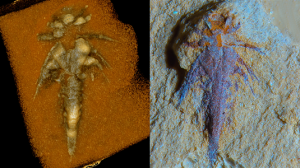
On the basis of an analysis of 520 million-year-old fossils, LMU researchers show that embryonic and larval development in the early ancestors of spiders and scorpions was strikingly and unexpectedly similar to that of modern crabs.
The shale formations of Chengjiang in southwestern China are a treasure trove for palaeontologists and evolutionary biologists. The fossils found there are over half a billion years old, and researchers have been excavating them since the 1980s. The specimens that have come to light are so diverse and, for the most part, so well preserved that they provide scientists with a very detailed picture of what animals looked like in the Early Cambrian. This was the period in Earth’s history when most of the major groups of animals represented in the biosphere today first evolved. Together with colleagues from Germany, China and the US, and with the aid of novel methods, LMU researchers have now obtained new insights into the evolution of ontogeny – the developmental process that leads to the transition from embryo to adult – in the taxon Arthropoda, an extremely diverse and abundant group of animals today, which includes the insects, spiders, centipedes and crustaceans. The new findings appear in the “Proceedings of the U.S. National Academy of Sciences”.
Dr. Yu Liu (Department of Biology II, currently Department of Earth & Environmental Science at LMU) and his colleagues are well acquainted with fossil specimens of the species Leanchoilia illecebrosa. This arthropod is thought to represent an early marine form of the chelicerates, the group that includes spiders, scorpions and mites, as well as the horseshoe “crab” Limulus polyphemus (which – unlike the true crabs – is not a crustacean). The adult representatives of L. illecebrosa previously analyzed by the Munich researchers were between 2 and 4 cm long, and they described an immature larva two years ago that measures only about 8 mm in length. In this new paper they report a fossil that is only 2 mm long and carries a pair of pincer-like appendages, each comprising three flagella-like elements together with four pairs of well-developed branched limbs in the head, and a spike-like posterior region or telson. The authors interpret this specimen as an even earlier larval stage of Leanchoilia.
New segments at a specialized growth zone
Some aspects of the new fossil surprised Yu Liu and his colleagues, because they do not conform to the pattern of development that would be expected for an early representative of the chelicerates, based on what is known about the evolutionary pathway that led to modern arthropods. For instance, the new larva has fewer body segments than the adult, and the limbs at the rear of the trunk are rudimentary. To the LMU team (which also included Prof. Dr. Roland Melzer, Dr. Joachim Haug and Dr. Carolin Haug of the Department Biology II) and their colleagues, these features are more reminiscent of the later larval stages of modern crustaceans. In crustaceans, only the first four segments are fully developed in the newly hatched larva. New segments are progressively added to the trunk at a specialized growth zone located just in front of the telson over the course of several further larval stages. For the scientists, the new specimen of L. illecebrosa is yet another example of how important it is “to consider not only the morphology of mature organisms, but also their development from embryo to adult,” i.e. the ontogenetic patterns, when reconstructing the evolution of animal groups.
The kind of detailed analysis carried out on this mini-larva “was made possible by a combination of several high-end methodologies,” says Yu Liu. Among other techniques, the team subjected samples of the shale to computerized microtomography (micro-CT). This permits investigators to reconstruct and examine the fossil in three dimensions, without the need to painstakingly remove the sedimentary material concealing it.
Reference:
Yu Liu et al. Three-dimensionally preserved minute larva of a great-appendage arthropod from the early Cambrian Chengjiang biota, Proceedings of the National Academy of Sciences (2016). DOI: 10.1073/pnas.1522899113
Note: The above post is reprinted from materials provided by Ludwig Maximilian University of Munich.










